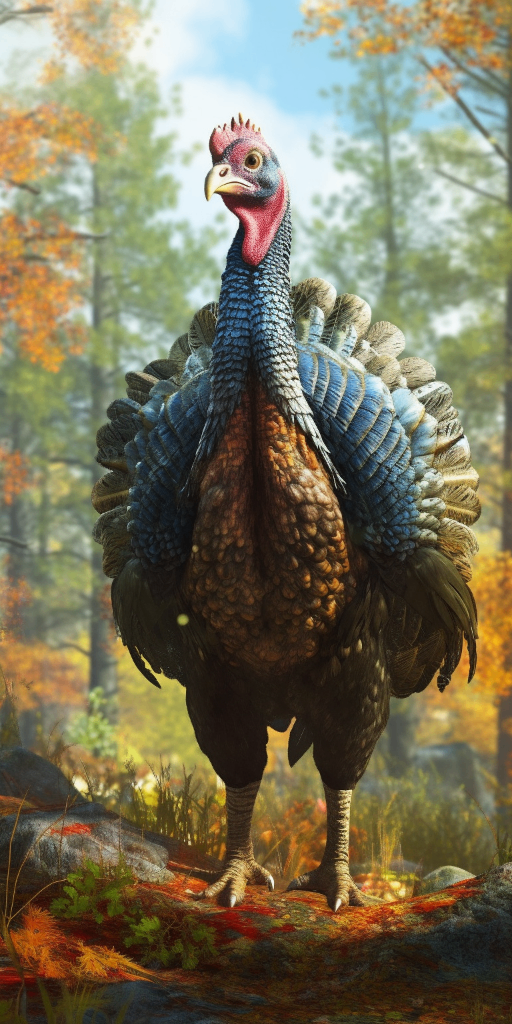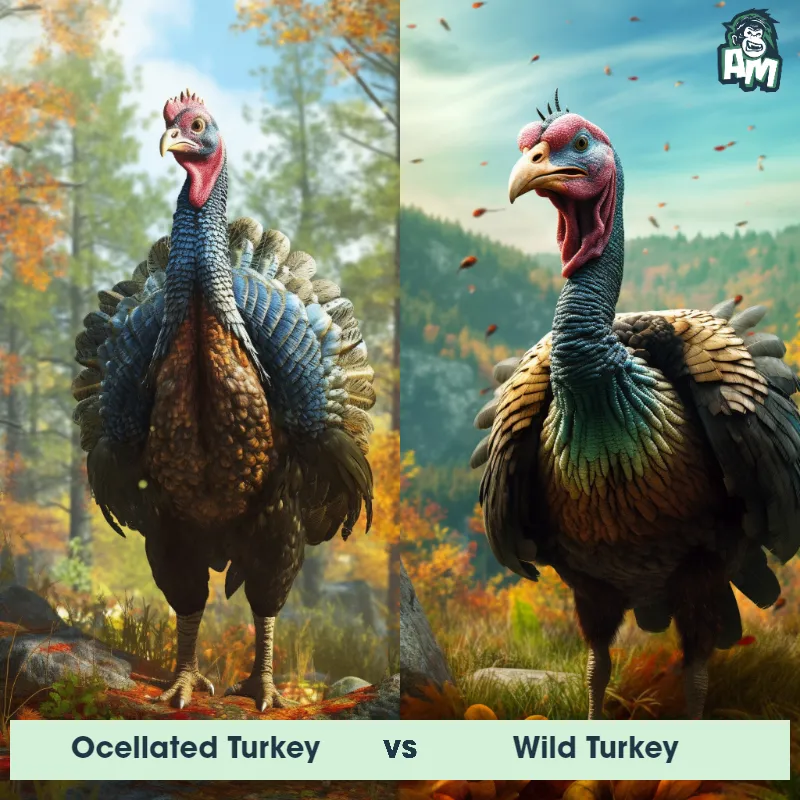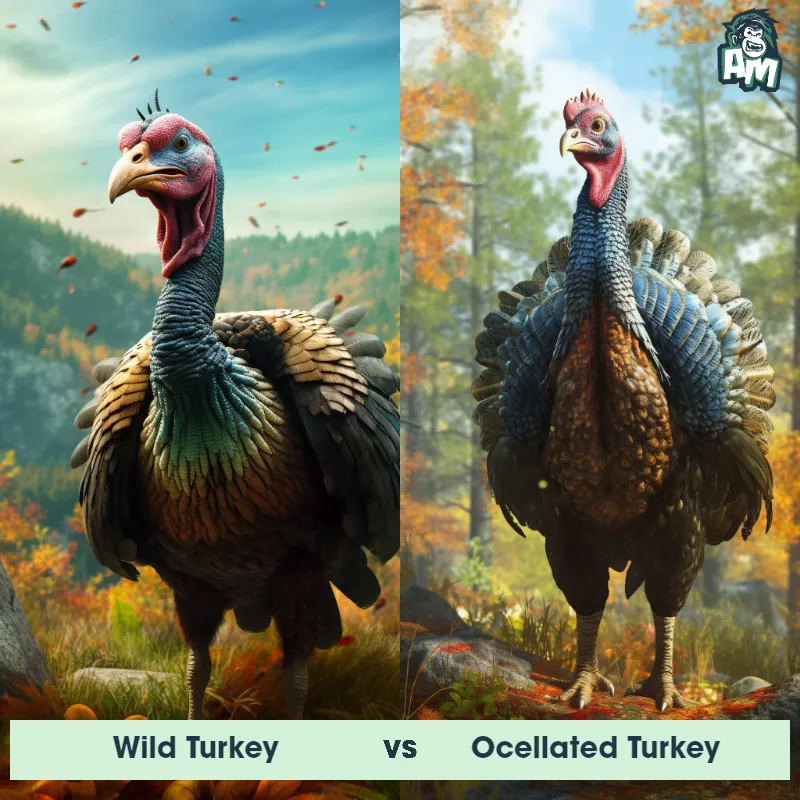The Ocellated Turkey
The Ocellated turkey, also known as Meleagris ocellata, is a species of turkey native to the Yucatán Peninsula in Mexico and northern Belize and Guatemala. Unlike its domesticated relative, the Ocellated turkey has strikingly beautiful plumage with iridescent feathers that shimmer in hues of bronze, green, blue, and gold. It is smaller than the wild turkey, with a body length of about 38-48 inches and a wingspan of approximately 48 inches. The males have a distinctive bone-like structure called a snood on their forehead, which becomes more prominent during courtship displays. They also possess long, colorful tail feathers that can reach up to 20 inches in length. Both males and females have a small, fleshy fold of skin called a wattle under their chins. They primarily inhabit tropical forests and feed on a diet of fruits, insects, seeds, and occasionally small reptiles. Ocellated turkeys are known for their loud vocalizations, which include a variety of calls and clucks.

| Ocellated Turkey | |
|---|---|
| Size | 4 feet (1.2 meters) in length |
| Weight | 8-12 pounds (3.6-5.4 kilograms) |
| Speed | Speed: 20 mph (32.19 km/hr) |
| Key Strength | Sharp spurs on legs |
| Biggest Weakness | Limited flight ability |
| Scientific Name | Meleagris ocellata |
| Family | Phasianidae |
| Habitat | Forests and jungles |
| Geography | Yucatán Peninsula in Mexico, Belize, and Guatemala |
| Diet | Omnivorous, feeds on insects, fruits, and seeds |
| Lifespan | 3 years - 4 years |

The Ocellated Turkey
The Ocellated turkey, also known as Meleagris ocellata, is a species of turkey native to the Yucatán Peninsula in Mexico and northern Belize and Guatemala. Unlike its domesticated relative, the Ocellated turkey has strikingly beautiful plumage with iridescent feathers that shimmer in hues of bronze, green, blue, and gold. It is smaller than the wild turkey, with a body length of about 38-48 inches and a wingspan of approximately 48 inches. The males have a distinctive bone-like structure called a snood on their forehead, which becomes more prominent during courtship displays. They also possess long, colorful tail feathers that can reach up to 20 inches in length. Both males and females have a small, fleshy fold of skin called a wattle under their chins. They primarily inhabit tropical forests and feed on a diet of fruits, insects, seeds, and occasionally small reptiles. Ocellated turkeys are known for their loud vocalizations, which include a variety of calls and clucks.
Fun Fact: The Ocellated turkey is not closely related to the common wild turkey found in North America; in fact, the two species belong to different genera.
| Ocellated Turkey | |
|---|---|
| Size | 4 feet (1.2 meters) in length |
| Weight | 8-12 pounds (3.6-5.4 kilograms) |
| Speed | Speed: 20 mph (32.19 km/hr) |
| Key Strength | Sharp spurs on legs |
| Biggest Weakness | Limited flight ability |
| Scientific Name | Meleagris ocellata |
| Family | Phasianidae |
| Habitat | Forests and jungles |
| Geography | Yucatán Peninsula in Mexico, Belize, and Guatemala |
| Diet | Omnivorous, feeds on insects, fruits, and seeds |
| Lifespan | 3 years - 4 years |
Ocellated Turkey Matchups
We use AI to simulate matchups between the Ocellated Turkey and other animals. Our simulation considers size, strength, and natural predatory behaviors to determine the most likely outcome.

Can't find the Matchup you want?
Create Your Own MatchupOcellated Turkey: Diet, Predators, Aggression, and Defensive Behaviors
What do Ocellated Turkeys eat?
Ocellated Turkeys primarily feed on fruits, seeds, insects, and small invertebrates found in their tropical forest habitats. They have a diverse diet that includes berries, acorns, small reptiles, and even small mammals. This varied diet helps them obtain the necessary nutrients to maintain their health and energy levels.
Do Ocellated Turkeys have any predators?
Yes, Ocellated Turkeys have several predators in their natural environment. Some of their main predators include large birds of prey like eagles, as well as ground predators like jaguars, ocelots, and margays. These predators pose a significant threat to Ocellated Turkeys, especially when they are young and more vulnerable.
Are Ocellated Turkeys aggressive?
Ocellated Turkeys are not particularly aggressive towards humans or other animals, unlike some other species of turkeys. They are known to be shy and elusive birds, often avoiding confrontation whenever possible. However, they may display more aggressive behavior during the breeding season when competing for mates.
Do Ocellated Turkeys fight?
During the breeding season, male Ocellated Turkeys may engage in displays of dominance and aggression towards rival males. This behavior can escalate into physical fights, where they use their sharp spurs and beaks to establish dominance and secure mating rights with females. These fights can be intense but are usually short-lived.
How do Ocellated Turkeys defend themselves?
Ocellated Turkeys have evolved various defense mechanisms to protect themselves from predators. Their cryptic plumage helps them blend into their forested surroundings, making it harder for predators to spot them. Additionally, they have keen eyesight and can quickly take flight to escape danger. They may also vocalize loudly to alert others of potential threats.
What is the biggest weakness of Ocellated Turkeys in a fight?
Despite their sharp spurs and beaks, Ocellated Turkeys are not as large or powerful as some other turkey species. This lack of size and strength can be a significant weakness in a fight, especially when facing larger and more aggressive competitors. In such situations, Ocellated Turkeys may rely more on agility and speed to avoid direct confrontations.
Fun Fact: One fascinating aspect of Ocellated turkeys is their unique courtship behavior. Males engage in elaborate displays to attract females, including puffing up their plumage, spreading out their tails, and emitting deep booming sounds.
Fun Fact: Ocellated turkeys have evolved an interesting adaptation to help them escape predators. When threatened, they have the ability to burst into sudden flight, revealing the vibrant, iridescent colors of their wings, momentarily confusing and distracting potential predators.












